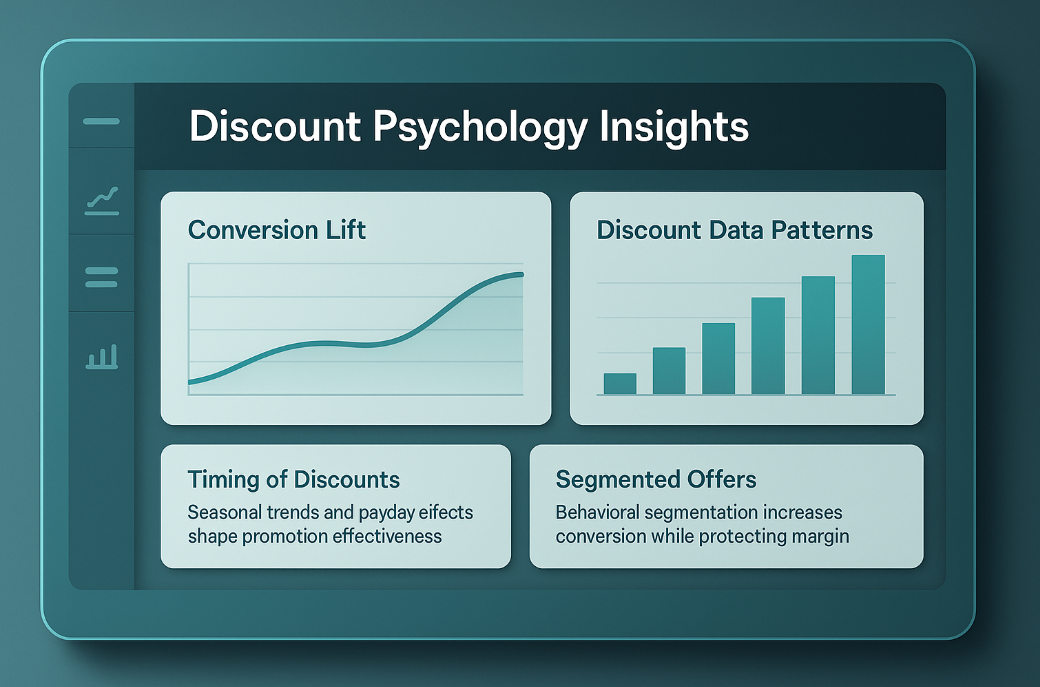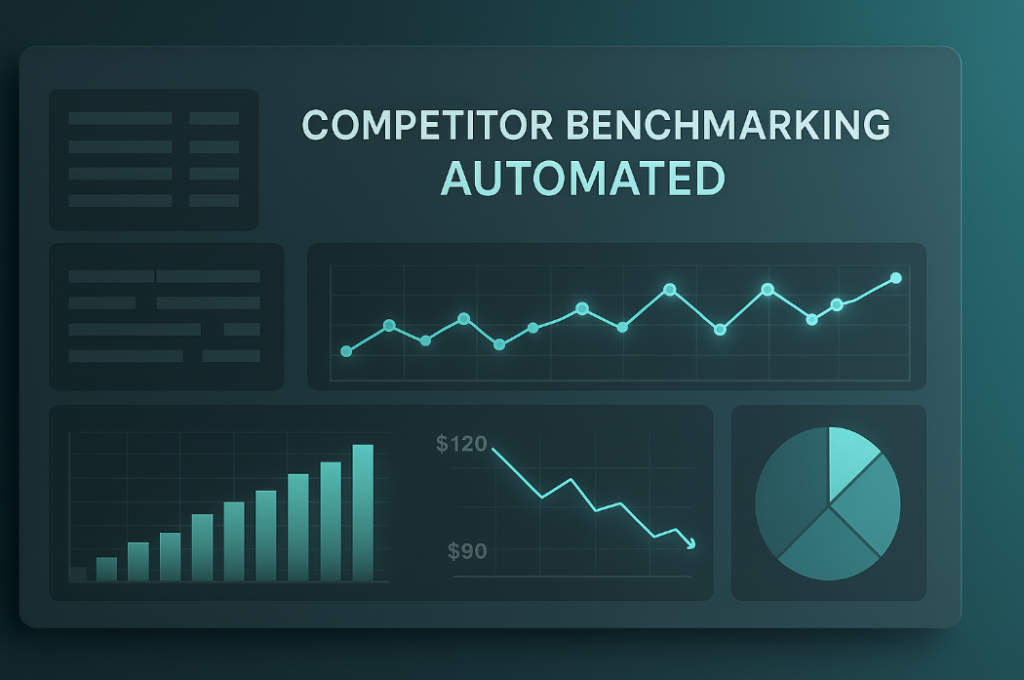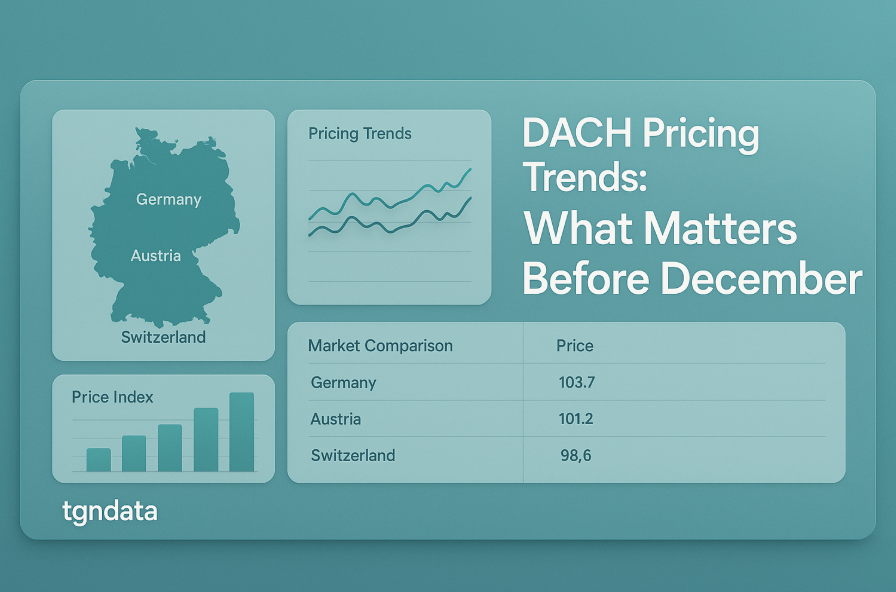- Product
- Solution for
For Your Industry
- Plans & Pricing
- Company
- Resources
For Your Industry
Discounts shape customer behavior more than almost any other pricing lever. They trigger emotion, influence decision making, reshape value perception and accelerate the moment a shopper moves from hesitation to purchase. Retailers often treat discounts as simple percentage cuts, yet the psychology behind discounts is far more structured. When analyzed with data, discount patterns can reveal powerful signals that explain why some promotions lift conversion while others barely move demand.
This article explores the psychology of discounts and the data patterns that consistently increase conversion. We examine how customers interpret price reductions, how context shifts discount effectiveness, why minor changes in presentation influence perceived value and how advanced analytics and competitive data help teams design smarter promotions. By understanding the psychological forces behind discount decisions, pricing teams can create more strategic and profitable promotional plans.

Discounts work because they alter how customers perceive value. When a product is discounted, the reduced price triggers both emotional and analytical responses. Customers feel they are gaining access to a better deal and they also shift their internal reference price. This combination creates momentum that increases conversion.
Successful promotions align psychological triggers with data driven insights. Teams must understand what motivates customers and what discourages them. They must know how discount depth affects demand, how timing shapes customer urgency and how competitive context changes expectations. The psychology of discounts is not guesswork. It is measurable and repeatable when supported by strong data.
Customers do not evaluate discounts through strict logic. Several cognitive biases influence their behavior. Understanding these biases helps pricing teams structure promotions that convert consistently.
Customers compare discounted prices with their internal reference price. If the discount meaningfully lowers the price relative to their expectations, conversion increases. Reference price is influenced by competitor pricing, historical pricing and category norms.
When customers first see a higher original price, they anchor to it. The discounted price appears more attractive in comparison. This effect improves conversion, especially if the original price is displayed prominently.
Customers want to avoid missing out on a deal. Limited time discounts or inventory based discounts leverage loss aversion to increase urgency.
Customers are more likely to respond to discounts when reviews or ratings reinforce product value. High rated products experience stronger uplift during promotions.
How the discount is presented influences perception. A discount framed as a monetary saving often outperforms the same discount framed as a percentage in categories where customers think in absolute value terms.
Discount framing refers to the way the promotion is communicated. The same discount depth can produce different outcomes depending on how it is framed.
Percentage based discounts are effective when prices are high because they highlight a larger saving. Monetary based discounts work better for low ticket items because customers can instantly understand the value.
Showing the original price increases conversion by strengthening the anchor. Without the original price, customers cannot easily compare value.
Round number discounts feel simpler and easier to interpret. Precise numbers can communicate deliberate pricing, which strengthens trust in certain categories.
When multiple discounted products appear together, customers compare relative savings. A premium option discounted more heavily can increase conversion for mid priced products.
Color cues, crossed out prices and bold typography significantly influence attention. These small visual changes create noticeable differences in conversion.
Analyzing thousands of promotions reveals consistent patterns that determine discount effectiveness.
Most categories have discount thresholds where conversion jumps sharply. These thresholds differ across categories but represent predictable points of customer responsiveness.
Discounts eventually reach a point where deeper reductions no longer generate meaningful gains. Identifying this point prevents unnecessary margin loss.
Price endings influence perception. Prices ending in nine or ninety nine outperform rounded prices, especially during promotions.
Low stock paired with discounts creates urgency. Customers respond disproportionately to scarcity combined with price savings.
Monitoring how discounts affect related or substitute products reveals which items are most price sensitive.
For replenishable items, repeated promotions increase lifetime value. Data helps determine when discounts stimulate ongoing behavior instead of one time conversions.
Competitive context plays a major role in how customers interpret a discount. A discount is not judged in isolation. Customers compare it with competitor prices and promotions.
A competitive price index provides a benchmark that helps teams understand how their prices compare with the market. When customers see a discount on a product that is already well positioned relative to competitors, the psychological impact is far stronger. Customers perceive the offer as a rare opportunity rather than a routine markdown. Data driven price index tracking shows when a product is slightly above or below market norms and indicates the level of discount required to shift customer perception. Even small discounts can deliver significant conversion gains when the product is close to market parity.
Promotion matching helps retailers remain competitive during peak promotional cycles. Customers closely compare offers across retailers, especially in high traffic periods. When a competitor launches a promotion, matching that offer or slightly improving it positions the retailer as a fair and competitive option. Data shows that customers often choose the retailer that responds fastest to competitive activity. Effective promotion matching requires real time monitoring, historical analysis and an understanding of which competitor actions truly influence demand.
Marketplace environments behave differently from traditional retail sites because customers have easy access to a wide range of sellers offering the same product. Small pricing differences can shift buy box visibility, search ranking and overall sales velocity. Discounts that secure the buy box position can multiply exposure, which directly increases conversion. Marketplace dynamics also reveal how aggressive competitors are and how quickly prices shift. Strong marketplace analytics help pricing teams determine whether a discount should be modest or more aggressive to remain competitive.
Retailer reputation influences how customers interpret discounts. A reputable retailer does not need to offer the deepest discount to generate strong conversion because customers trust delivery speed, product authenticity and service quality. In contrast, unknown sellers often require higher discount depths to compensate for trust gaps. Reputation also shapes how customers interpret value and reliability. Combining reputation insights with discount strategy allows retailers to optimize margins while maintaining competitive appeal.
Timing shapes customer intent and dramatically influences discount performance. Even when discount depth remains constant, conversion rates often vary based on seasonal patterns, daily activity cycles and competitive timing. Customers respond differently depending on when they shop, how much time they have available and how retailers position promotional events. The most successful discount strategies rely on data that reveals not only what discount to offer but when to offer it. Timing determines whether a promotion feels relevant, urgent or strategically aligned with customer interest.
Seasonal timing influences emotional readiness and purchase motivation. Customers anticipate deals during holidays, back to school periods and category specific peaks such as garden season or winter sports. These predictable cycles create opportunities for retailers to optimize conversion with strategically placed promotions. Seasonal timing also supports demand forecasting because customers exhibit consistent patterns year after year. Retailers that align discount depth and timing with seasonal demand curves achieve stronger promotional efficiency.
Weekday and weekend shopping patterns show clear behavioral differences. Weekdays often bring browsing and research activity, while weekends generate stronger purchase intent. Evening hours also show elevated engagement as customers have more time to compare options. Retailers who align promotions with these natural rhythms improve conversion without increasing discount depth. Timing analysis helps identify the days and hours when customers are most responsive.
Payday cycles are among the most reliable timing indicators. Customers experience a psychological sense of renewed financial flexibility immediately after receiving income. This creates a window where they are more open to purchasing discretionary items. Discounts launched during payday periods produce stronger results because the financial barrier is lower. Pricing teams can map regional payday cycles to optimize promotional timing across markets.
Clearance cycles require precise timing to avoid margin loss or inventory risk. Data driven retailers analyze sales velocity, seasonal transitions and competitor activity to determine when to begin markdowns. Discounts placed too early reduce full price opportunities, while discounts placed too late risk stockouts or leftover inventory. Effective clearance strategies balance speed and profitability by monitoring real time inventory performance.
Competitor timing influences how customers perceive discount value. When competitors run simultaneous promotions, customers compare heavily and often choose retailers who differentiate timing or offer stronger value. Launching discounts slightly before or after competitors increases visibility and avoids promotional clutter. Competitor timing analysis helps retailers identify optimal launch windows that maximize promotional attention and conversion.
Personalized discounting recognizes that customers respond to promotions differently based on their preferences, purchasing history and behavioral patterns. Instead of applying blanket discounts to all shoppers, segmented strategies tailor the discount experience to the right audience. This approach increases conversion while reducing unnecessary margin loss. Data driven segmentation ensures that promotional investments target customers who are most likely to respond positively.
Behavioral segmentation divides customers into groups based on their browsing habits, engagement signals and past purchasing behavior. Some customers show repeated interest in specific categories, while others respond only when discounts reach certain thresholds. Behavioral insights reveal which shoppers are discount motivated and which rely more on brand loyalty or product features. By analyzing these behavioral indicators, retailers can align discount depth with the true needs and motivations of each segment.
High value customers often respond best to exclusive access and early event invitations rather than large discounts. These customers care about convenience, priority availability and product quality. Offering them moderate but meaningful discounts strengthens loyalty and increases long term engagement. For these customers, the psychological value of exclusivity outweighs the need for deeper price cuts.
Price sensitive customers often look for straightforward and highly visible promotions. They respond well to clear percentage or monetary reductions that highlight savings. By identifying these customers early in their journey, retailers can present targeted offers that increase conversion without applying deep reductions to shoppers who would have purchased without a discount. This precision reduces margin erosion.
Cart abandonment discounts target customers who demonstrated strong interest but did not complete their purchase. These offers work because they address hesitation at a critical moment. By analyzing browse behavior, product page interactions and cart composition, retailers can determine whether a small discount or a stronger incentive is needed to recover the conversion. Timely communication and contextual relevance are key.
Retention discounts help prevent churn by encouraging customers to return after a period of inactivity. These offers work especially well in subscription categories or consumable product lines. Data driven retention strategies help teams identify which customers are at risk and what type of offer will reengage them effectively. Personalizing timing, depth and messaging improves retention impact.
Different discount types activate different psychological triggers. Some communicate simplicity, others encourage exploration and some attract customers focused on value stacking or convenience. Understanding how each discount type influences decision making helps pricing teams match the right offer to the right category and customer segment.
Percentage discounts appeal to customers who prefer quick mental comparisons. They work well when original prices are high because the percentage conveys strong value even if the monetary savings vary. Customers often perceive a twenty percent reduction as significant even when they do not calculate the exact savings. This effect is strongest in categories with higher price points.
Monetary discounts excel when products have lower prices or when customers want immediate clarity on the value they receive. A five dollar reduction on a household item feels more concrete than a percentage discount. These promotions simplify decision making and reduce cognitive effort, especially in convenience driven categories.
Buy One Get One offers increase cart size and perceived value without reducing anchor price. Customers interpret these offers as opportunities to maximize value. They are especially effective for consumables and items with high repeat purchase rates. BOGO promotions also support inventory movement and help retailers clear stock while maintaining strong perceived value.
Bundle discounts increase average order value by grouping complementary products together. Customers perceive bundled savings as a smarter purchase decision because it solves a complete need rather than addressing a single item. Bundling reduces decision friction and strengthens cross sell performance. These promotions often create higher satisfaction rates because customers feel they are receiving a comprehensive solution.
Loyalty discounts strengthen the relationship between customer and brand. They create a sense of appreciation and exclusivity, even when discount depth is moderate. These offers often drive long term value rather than short term conversion spikes. Loyalty driven promotions reinforce retention strategies and improve customer lifetime value.
Limited time offers increase urgency by creating a clear time boundary. Customers worry they may lose the opportunity, which activates loss aversion. These offers work best during peak shopping periods or competitive events. Strong visual cues such as timers and prominent highlights increase their effectiveness.
Retailers can predict which discounts will succeed by analyzing behavioral signals. These signals reveal customer intent and identify hesitation patterns that discounts can help overcome. Understanding behavioral dynamics allows teams to run fewer but more effective promotions.
A high number of product page views that convert into cart additions suggests strong interest. If conversion remains low after cart addition, even minor discounts help remove hesitation. This metric identifies products that need a small push rather than deep markdowns.
When customers spend considerable time on a product page, they are evaluating features, price or value. Introducing a well timed discount during periods of high engagement helps convert this interest into action. High dwell time often precedes strong promotional response.
Traffic from price comparison engines signals heightened price sensitivity. Customers in this flow respond strongly to competitive discounts, especially when the competitor landscape shows clear price gaps. Monitoring comparison activity helps identify the right moment to activate promotions.
Products with strong ratings convert more easily during promotions because customers feel confident that the deal represents both value and quality. Negative sentiment weakens promotion impact. Understanding sentiment allows teams to adjust discount depth accordingly.
Repeat visits signal intent and curiosity. Customers return because something about the product attracts them, yet they remain hesitant. A targeted discount often provides the final motivation needed to complete the purchase.
A strong discount strategy blends psychology with data. It uses behavioral indicators, competitive insights and conversion modeling to determine the optimal promotional opportunities. Data driven discounting helps retailers design targeted promotions that attract customers, differentiate from competitors and maintain long term profitability.
Reference price models identify the price customers expect to pay. When current prices exceed this expectation, discounts help narrow the gap and boost conversion. These models inform how deep discounts must be to shift customer perception and drive meaningful action.
Every category has threshold levels where small increases in discount depth create significant lifts in conversion. Identifying these thresholds helps pricing teams avoid unnecessary markdowns that do not produce proportional gains. Threshold analysis improves promotional efficiency and ensures that discounts are aligned with real customer sensitivity points.
Competitive context influences promotion performance. Teams must track competitor pricing, promotional timing and assortment shifts to ensure that discount strategies align with market expectations. Competitive intelligence prevents costly over discounting and increases promotional relevance by ensuring the offer stands out in the marketplace.
Segmentation helps tailor discount strategies to customer groups that respond best. This increases conversion while reducing blanket reductions that erode margin unnecessarily. Segment based discounting delivers precision and efficiency, improving both customer satisfaction and margin health.
A B testing provides real evidence of what works. Testing discount depth, timing, framing and presentation helps teams refine strategies and avoid relying on intuition alone. Continuous testing ensures promotional improvement over time and builds a library of insights that strengthen future campaigns.
Deep discounts may lift conversion quickly, but they risk long term brand erosion. Data driven strategies focus on targeted and purposeful discounts rather than repeated heavy reductions. Maintaining discipline prevents discount addiction and promotes sustainable performance.
Even strong promotional strategies can fail if common mistakes are not addressed. Many retailers rely on discounting as a default tactic rather than a strategic tool, which leads to wasted margin and inconsistent performance.
Over discounting reduces perceived product value over time. Customers learn to wait for promotions rather than purchasing at regular price. This behavior undermines revenue consistency and forces retailers into a cycle of repeated markdowns.
Discounts do not exist in isolation. If competitors offer stronger or more compelling promotions, customers will shift quickly. Teams that ignore competitor activity risk launching ineffective promotions that fail to stand out.
Price sensitive customers often look for straightforward and highly visible promotions. They respond well to clear percentage or monetary reductions that highlight savings. By identifying these customers early in their journey, retailers can present targeted offers that increase conversion without applying deep reductions to shoppers who would have purchased without a discount. This precision reduces margin erosion.
Weak framing reduces the impact of even a well planned discount. Missing original prices, unclear messaging or visually understated discount elements prevent customers from understanding the value of the offer. Strong framing is essential to ensure customers recognize the benefit.
Timing misalignment reduces promotional efficiency. Discounts launched at the wrong moment fail to capture demand. Data driven timing helps ensure discounts appear when customers are most receptive.
Different categories respond to different promotion types. Applying the wrong discount type creates friction and reduces performance. Category alignment improves promotional resonance and ensures discounts meet customer expectations.
Discount psychology connects emotion, behavior, and data to reveal how customers interpret value and make purchase decisions. Retailers who understand these patterns can design promotions that convert more effectively, reduce unnecessary margin loss, and better compete in fast-moving markets. Insights such as timing, competitive context, customer segmentation, and discount framing all work together to create predictable uplift when used strategically.
If your team wants to build smarter, data-powered discount strategies, tgndata provides the competitive intelligence and analytics foundation to support stronger decisions. Our platform delivers accurate market data, pricing insights, and automated workflows that help you design promotions with clarity and confidence. Connect with tgndata to elevate your discount performance and drive sustainable growth.













Missing an important marketplace?
Send us your request to add it!